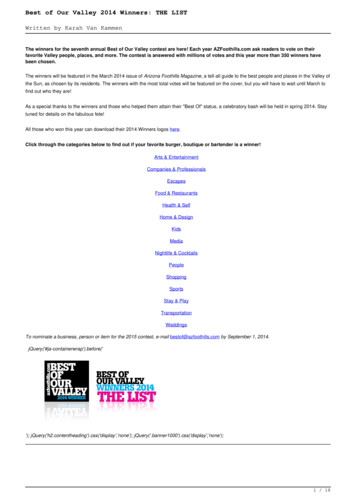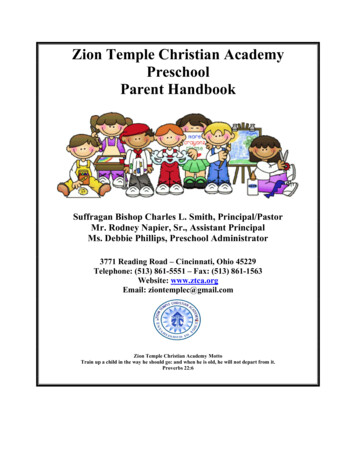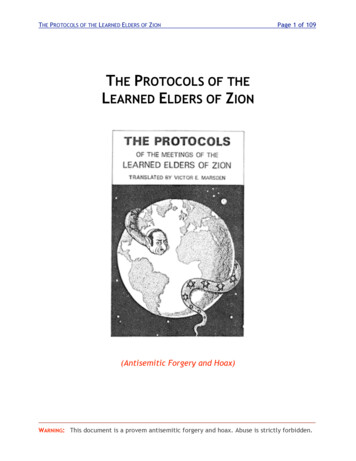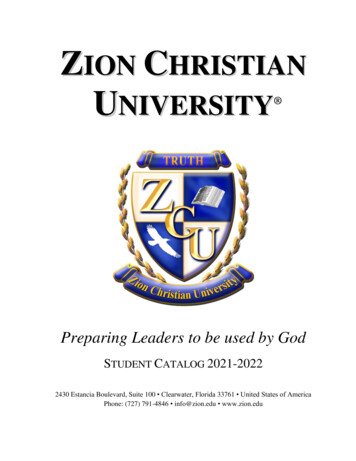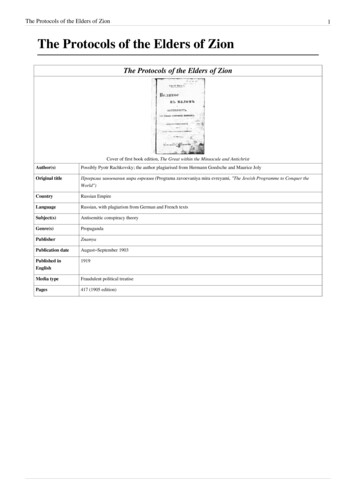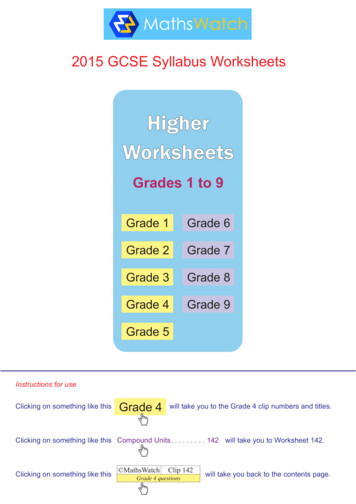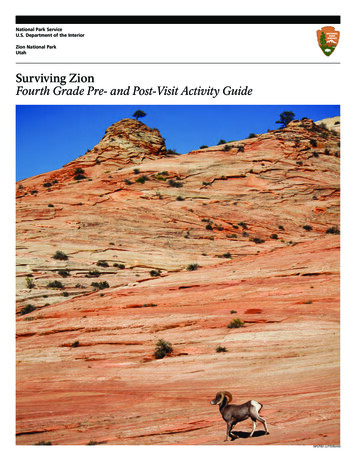
Transcription
National Park ServiceU.S. Department of the InteriorZion National ParkUtahSurviving ZionFourth Grade Pre- and Post-Visit Activity GuideNPS/TIM LUTTERMAN
Surviving ZionFourth Grade Pre-Visit and Post-Visit Activity GuideZion National ParkSpringdale, Utah 84767December 2010ContentsIntroduction1Core Connections1Background1Pre-Visit Activities2Post-Visit Activities7What’s My Adaptation?Plant DetectivesA Beaver’s TaleNo Thumbs! RelayAdaptation AuctionInterview With a Plant235779Glossary10References12
IntroductionThemeDesert plants and animals each have a specialset of adaptations that make them well-suitedfor their particular habitat.FocusNPS/ADRIENNE FITZGERALDPlant and animal adaptations in variedhabitats.Pre-Visit Activities1. What’s My Adaptation? – Students willtake on the identity of a specifc plant oranimal that resides in Zion National Park tobetter understand how its adaptations aid insurvival.NPS/MARC NEIDIG2. Plant Detectives – Using a series of imagesand experiments, students will investigatesome ways plants are adapted to their habitat.3. A Beaver’s Tale – By reading a story,students will discover a Native Americanlegend describing the development of abeaver and the role special adaptations play.Post-Visit ActivitiesNPS/CAITLIN CECIA tadpole, fourwing saltbush,and a rock squirrel are alladapted to their habitat.Core ConnectionsUtah Core CurriculumFourth Grade ScienceStandard 5: Students willunderstand the physical characteristics of Utah’s wetlands,forests, and deserts, and identifycommon organisms for eachenvironment.Objective 1: Describe thephysical characteristics ofUtah’s wetlands, forests anddeserts.Objective 2: Describe thecommon plants and animalsfoundUtah’s environmentsThisis aincaptionfor the introducandphotograph.how these organismshavetionThe bottomedgeof theimagealigns withadaptedto theenvironmentinthebaselinesof the last lines ofwhichthey live.text on this page.1. No Thumbs! - In an exciting relay race,students experience life without one specialhuman adaptation.2. Adaptation Auction - Students work ingroups to bid on particular adaptations. Eachgroup will use the adaptations they win tobuild a unique animal that is well-suited to aspecifc habitat.3. Interview with a Plant - By role-playing andinterviewing, students will gain an understanding of plant species and discover the linkbetween adaptations and habitat.BackgroundPlants and animals possess unique adaptationsthat make each well-suited for their particularhabitats. Zion National Park is made up of avariety of habitats, each with its own speciallyadapted plants and animals. The park servesas a sanctuary to a wide variety of plants,animals, and other life (biodiversity).Diferent environments present uniquechallenges and opportunities for plants to survive. Over time, changes that provebenefcial may be passed on to the next generationresulting in adaptations.Plants in desert environments rely on physicaladaptations to survive extreme temperature(e.g., heat, cold), sunlight, soil content, andwater availability. Features such as small leaveshelp reduce moisture loss (transpiration) byreducing the surface area and subsequentexposure to wind and sun. A hairy coatingon a plant’s surface helps control temperature by limiting exposure to direct sunlightand reducing water loss. Some plants havea waxy coating to reduce water loss as well.Plants such as cacti have spines to protect theplant from being eaten and provide increasedshade. Succulence, the ability to store water inspecial tissue, is another adaptive feature.Plants in riparian, or waterside areas, dealinstead with shade and soil saturation.Adaptations such as strong roots and stifstalks help riparian plants stay erect in moistsoil. Some plants utilize the available fowingwater to disperse their seeds.Animals, too, are adapted to life in particularhabitats. Animals not only possess physicaladaptations, but behavioral adaptations aswell. Behaviors can be altered to best serve theanimal in a given situation or environment.The ability of animals to move allows travelbetween diferent environments resulting insome species being found in multiple habitats.Still, these animals remain well adapted forthe habitat that they occupy.Behavioral adaptations include lifestyles suchas being nocturnal or diurnal, and practicessuch as burrowing and migration. Physicaladaptations in animals range from a beaver’sinsulting fur to a lizard’s water-saving scales.Talons, claws, fat molars, and pointed canineteeth are all physical adaptations.Fourth Grade Pre- and Post-Visit Activity Guide 1
Pre-Visit Activities1. What’s My Adaptation?Materials Yarn/string (approximately two feet perstudent)Digital image of ADAPTS acronym andprickly pear. Download or view theimages at What’s My Adaptation Images30 animal/plant adaptation cardsDownload or view the cards atWhat’s My Adaptation? CardsDuration: 30 MinutesLocation: ClassroomKey Vocabulary: amphibian, behavioral adaptation, bird, cone, coniferous,deciduous, environment, habitat, invertebrate,mammal, physical adaptation, pollinator,reptile, succulent, vertebrateSuggested Procedure1.Show students the acronym ADAPTS andtell them it stands for Animals Depend onActivities and Parts to Survive. Introducethe concept of adaptation and discusshow animal body parts, actions, andbehaviors help them survive in a givenhabitat. Have students think of severalanimal actions and body parts, anddiscuss how each adaptation might helpthe animal survive. As animals, humansalso have adaptations. Have studentsthink of what features and/or behaviorshelp humans survive (e.g., two legs,opposable thumbs, walking upright,shelter building).2.Explain that plants have physicaladaptations that help them survive. Showstudents the image of a prickly pear anddiscuss its physical adaptations (i.e.,spines to protect it from being eaten andObjectivesStudents will be able to: a) describe or give anexample of an adaptation, and b) name twohabitat characteristics to which an organismmay adapt.MethodUsing observations and a guessing game,students will become familiar with someof Zion National Park’s plant and animalresidents and their adaptations.BackgroundMany diferent plants and animals live in ZionNational Park, each with their own unique setof adaptations which help them survive. Thisactivity will introduce students to a variety ofZion’s plant and animal residents and someadaptations each possess.NPS PHOTOA prickly pear has many adaptations that help it survive the conditions of its habitat.Fourth Grade Pre- and Post-Visit Activity Guide 2
shade it from the sun, thick pads to storewater, waxy coating to prevent moistureloss). Explain that plants have manyphysical adaptations and that they mayvary depending on the environment.Stress that humans or other animalscan sometimes change their behavior inresponse to new situations, but physicaladaptations develop much more slowly,over generations. Discuss conditions inwhich a plant or animal in Zion wouldneed to adapt, including lack of water, hotsummertime temperatures, cold winternights, snow, and/or wind.3.4.To begin the “What’s My Adaptation?”game, have students close their eyes andhang an animal/plant adaptation cardaround their neck with the image on theirback, facing outward. Instruct studentsto open their eyes without looking attheir own adaptation cards. Show thema sample (perhaps the prickly pear fromearlier), and tell them each picture is aplant or animal that lives locally. Instructstudents to ask other students yes or noquestions to try to determine the name ofthe organism on their card. A student mayask another up to three questions beforemoving on to another student. Reviewexamples of good questions before thestudents begin. Good questions should bespecifc, such as, “Am I a plant?”, “Do Ihave fur?”, and “Do I live in the desert?”.When students determine their specifcorganism, they should sit and write downthree adaptations they think the animalor plant has that help them survive. Oncecompleted, students should turn theircard with the image face down and readthe list of selected adaptations for theirorganism.EvaluationHave students present their information.When all students are seated, ask forvolunteers to share their identities andadaptations. They may introduce themselvesto the class in frst person as if they are theplant or animal and share some of theiradaptations out loud.ExtensionDiscuss adaptations in relation to traits passedfrom parent to ofspring. Tell students thatoccasionally an organism develops adiferent trait because of a change or“mistake” in the genetic code. If the trait helpsthe plant or animal survive, it may be passeddown to its ofspring and becomes thebeginning of an adaptation. If the new traitdoes not help, the plant or animal may notsurvive to reproduce and, therefore, the traitmay not be passed along to develop into anadaptation. Each plant or animal in the desert,or any other habitat, developed adaptationsthat made them more likely to survive thanorganisms without these adaptations.2. Plant DetectivesDuration: 45 minutesLocation: ClassroomKey Vocabulary: adaptation,conservation, desert, riparian area, succulenceObjectivesAfter this activity, students will be able toa) understand how diferent adaptationsallow plants to survive diferent habitats,and b) name two ways leaf structures areadaptations.MethodUsing a series of experiences students willexplore the role of leaf structure in plantsurvival.BackgroundRiparian or water-side areas in Zion NationalPark provide a very diferent habitat thandrier, more arid desert areas nearby. Plantsthat occupy these areas have diferent adaptations more suitable for their environment.This activity will familiarize students with thenotion that plants are adapted to theirhabitat. Diferent plants in the same habitatoften express similar adaptations. In general,plants occupying desert habitats may besucculent (they have feshy tissues for waterstorage) or often have protective layers ontheir leaves and stems, such as waxy or hairycoatings, to help conserve or store water. DueFourth Grade Pre- and Post-Visit Activity Guide 3
“Riparian, or water-side areasin Zion National Park providea very diferent habitat thanthe drier, more arid desertareas nearby.”to greater water availability, plants in riparianareas don’t need the same water conservationor storage mechanisms as other desert plants.2.Materials: Pictures of local desert and riparianhabitats, and associated plantsThree thick sponges cut in halfThree thin sponges cut in halfSix small sealable plastic bags (quart-sizeor similar)12 dishes or bowls12 measuring cups or graduated cylindersWaterOptional: 6 funnelsDownload or view applicable images atPlant Detectives ImagesShow students various plant images andask in which of the two habitats, desert orriparian, do they belong. Showstudents the desert plant group image.Ask students to make observations aboutwhat these plants have in common. Nowlook at the riparian group image. What dothese plants have in common? Comparethe two plant groups side-by-side. Whatare the major diferences (e.g., color,shape, thickness)? Inform students thatthey are going to be plant detectives andinvestigate some of these diferences.Using sponges to simulate plant leavesthey will discover how succulence andleaf coatings afect leaves and plants.Suggested ProcedureLeaf StructureSucculence1.3.Give each group one thick and one thinsponge. Have them put each spongein a dish or bowl. Have students usegraduated cylinders or measuring cups topour equal amounts of water over eachsponge. Allow the moistened sponges tosit for one minute. Use this time toexplain how each sponge acts as a leafand the water simulates rainfall or snowmelt.4.Have groups squeeze the small spongeinto a measuring cup or graduatedcylinder. You may need a funnel to assistwith this process. Repeat this process withDiscuss the idea that diferent habitats arepopulated by diferent types of plants andanimals. For example, polar bears live innorthern polar habitats versus black bearswhich live in forest habitats. Each habitatpresents diferent conditions in whichplants or animals have adapted. Thus,many plants living in the same habitathave similar adaptations. Show studentsdesert and riparian habitat images andcompare and contrast the two areas. Howmight variables like water availabilityaccount for the diferent appearances?NPS PHOTO/ADRIENNE FITZGERALDPlants that live in the desert have adaptations to survive the dry conditions.Fourth Grade Pre- and Post-Visit Activity Guide 4
the thicker sponge. Have the studentscompare the two cups. Which containsmore water? Have students calculate thediference between the two cups bysubtracting. As an option, studentscan calculate fractions of the originalwater amount each sponge captured andcompare the diferences. Have studentspredict which sponge will dry faster. Willthey dry faster in sun or shade? Place thesponges from one group aside to test thehypothesis and revisit the sponges hourslater.NPS PHOTOLeaf Coverings5.NPS/CAITLIN CECINPS/MARC NEIDIGLeaf shape, surface, andstructure are all adaptations.Give each group two thin, dry sponges.Place each sponge in a dry dish or bowl.Have students measure and pour a givenamount of water over each sponge. Allowthe sponges to sit for one minute. Use thistime to discuss the diferent elements inthe experiment.6.Have students place one sponge inside aplastic bag.7.Students should squeeze each spongeover separate measuring cups whileleaving one sponge inside the bag. Havethem compare the amount of water thatcomes out of each sponge. What did thebag do for the sponge? (It helped sealthe water inside). In this demonstration,the bag acts like a tough, waxy outercoating on a leaf, keeping moisture inside.Have students predict which of thesetwo sponges will dry faster. Place thesponges from one group aside to test thehypothesis. Revisit the sponges later.EvaluationUsing observations from the above activitieshave students brainstorm lists of traits helpfulto plants in riparian and desert habitats. Basedon the two experiments, have students decidewhich adaptations are better suited to desertplants and which to riparian plants. Woulda desert plant beneft more from a thick leaflike the thicker sponge (succulent) or a thinleaf like the thinner sponge (not succulent)?Would a desert plant beneft more from aleaf with a waxy outer coating or not? Whatabout plants in the riparian habitat? What areexamples of plants that display these diferenttraits? Use images from the beginning of theactivity to assist the students.ExtensionStudents now know certain plants arebetter suited for certain habitats. What wouldhappen if we took a plant normally found inmoister areas, for example a cottonwood tree,and plant it in a desert habitat? Have studentsthink about plants in their home yard or attheir school. What adaptations do these plantshave? Are they in the right habitat? Introducethe idea of native plant landscaping and giveexamples of where students can see this. Havestudents design a new landscape for theirschool or home that uses native plants in thenatural habitat.3. A Beaver’s TaleDuration: 45 minutesLocation: IndoorsKey Vocabulary: adaptation,behavioral adaptation, crepuscular, diurnal,legend, nocturnal, physical adaptationObjectivesAfter this activity, students will be ableto a) name two beaver adaptations, andb) understand that animal adaptations havechanged over time.MethodBy reading a Paiute legend, students willbecome familiar with the dynamic natureof adaptations as well as specifc beaveradaptations.BackgroundThe Paiute occupied much of southern Utahbefore the arrival of Euro-Americans andcontinue to live in the area today. Theirlegends were used to explain the surroundingworld. Paiute stories tell the origin andbehaviors of many living things.Materials: “How the Beaver Lost the Hair on His Tail”from Why the North Star Stands Still byWilliam R. Palmer. (Copyright 1946, William R. Palmer. Copyright 1978, ZionNational History Association). Downloadthe story at A Beaver’s TalePaper and pencils for students.Fourth Grade Pre- and Post-Visit Activity Guide 5
NPS PHOTOA beaver exhibits many adaptations to suit its riparian habitat.If desired, break the class into smaller groupsto discuss the story.sharp talons (e.g., hawks and eagles) use thistrait to better hunt and kill prey. Suppose thebeaver decided not to move into the river. What functions did the beaver’s tail servein the beginning of the story? How were these adaptations helpful forthe beaver’s lifestyle?Just like the beaver in the story, beavers arecrepuscular, active at dawn and dusk, andnocturnal, active at night. What caused the beaver to lose the hairon its tail? Is being nocturnal or crepuscular anadaptation? How did the beaver’s life change once itlost the hair on its tail?What new purposes did the hairless tailserve? What type of adaptation is it (physical orbehavioral)? What beneft might these behaviors serve? How would a beaver’s life be diferent if itwas diurnal, active during the day?Suggested Procedure Explain how adaptations are features whichchange slowly over time to help the animalsurvive in its habitat. The beaver storyillustrates what might happen over thousandsor millions of years. For example, birds withwebbed feet (e.g., ducks) use this trait to livemore efciently in water, while birds withWould his new tail serve him well onland? Why or why not?ExtensionHave students write and illustrate their ownlegends to describe how a local plant oranimal adaptation developed.Fourth Grade Pre- and Post-Visit Activity Guide 6
Post-Visit Activities4.Divide the class into two or three groupsand give each team a piece of yarn orstring. The frst team member will runup to the object (e.g., fence, bench, etc.),tie the piece of yarn to it, and run back.No thumbs can be used while tying. Thesecond team member will run up anduntie the string without using thumbs,and bring it back to the third teammember. One person ties and the nextunties until the relay is over. Complete therelay a second time, moving the personin the front to the back of the line, so thateveryone has a chance to tie and untie theyarn without using their thumbs.5.After the race, have students help eachother carefully remove the tape anddispose of it properly.1. No Thumbs! RelayDuration: 30 minutesLocation: Large open space, preferablyoutdoors.Key Vocabulary: adaptation, opposablethumb, physical adaptationNPS/CAITLIN CECIObjectivesAfter this activity, the students will beable to: a) describe an opposable thumb,b) describe how opposable thumbs are useful,and c) discuss other human adaptations.MethodUsing a relay race activity, the students willbecome familiar with the presence andimportance of human adaptations.EvaluationNPS/CAITLIN CECIBackgroundNPS/CAITLIN CECIBipedal motion, binocular visionand opposable thumbs are allhuman adaptations.Like any other living thing, humans havemany adaptations, both behavioral andphysical, that help us survive. Things such asskin and eye color, big brains, walking upright,bipedal (two-legged) motion, binocular vision(both eyes in front and working together),opposable thumbs, etc. Many other animalshave some or all of these adaptations.Opposable thumbs allow humans to touch allof our other fngers and grasp objects in a waythat only apes and monkeys can. By using ourbrains we have learned to build andmanipulate objects as few other animals can.Materials Masking tapeTwo or three 12-inch pieces of yarnHave students discuss the activity. Askstudents what it was like to be “thumbless”.Was it easier to tie or untie the string? Why?What would the world be like today if wenever had thumbs? Would humans have beenable to develop things like a written language,art, music, or technology? Tell students to tryother activities without their thumbs such asdrawing, buttoning their shirts, etc.ExtensionHave students think about what newadaptations they would give themselves. Youcan decide if they adaptations are real orimaginary. Have them write or draw what theywould be like with their new adaptation andhow it would help them survive.2. Adaptation AuctionSuggested Procedure1.Ask students if they think humans haveany adaptations. Discuss what humanadaptations are. Ask students what theythink life would be like without theseadaptations.2.Choose an area and set up relay linesabout 50 feet from any low, reachableobject such as a bench, fence, or bike rack.3.Tape their thumbs to their palms oralongside their hands. Run the tapearound their hands a few times, howevertake care not to cut of circulation.Duration: One HourLocation: ClassroomKey Vocabulary: adaptation, aestivation,amphibian, bird, camoufage, canine teeth,changeable pigmentation, compound eyes,hibernation, insect, mammal, migration,omnivorous, prehensile tail, quills, reptile,whiskersObjectivesAfter completing this activity, the studentswill be able to: a) identify a number of different adaptations, b) describe how diferentadaptations are suited to diferent habitats,Fourth Grade Pre- and Post-Visit Activity Guide 7
in their assigned habitat. Students mayview the list of adaptations ahead of timeto help budget their money. Give eachgroup fve to ten minutes to plan theirspending. Have groups elect a treasurerand a speaker. The treasurer will beresponsible for tallying and displaying thegroup’s fnancial status on a smalldry-erase board or a large sheet of paper.The bidder is the one who will raise thehabitat card to bid. You may consideralternating jobs during diferent rounds.and c) understand that each animal possessesa unique combination of adaptations.MethodUsing a mock auction, students will bid onadaptations to create an animal well-suited toa particular habitat.BackgroundEvery animal possesses a unique set of adaptations that help it survive in a particular habitat.Materials: Drawing supplies and paperBell or other sound maker“Adaptations for Auction” list. Downloador view the list atAdaptations for Auction30 adaptation cardsDownload or view the cards atAdaptation Auction CardsSix habitat cards. Download or view thecards atAdaptations for Auction Habitat Cards2.Open the bidding on an adaptation at asmall amount, such as “forward facingeyes” for 20. Remind students that oncethey run out of money they can no longerpurchase adaptations. Students can taketurns as bidder; however, the group mustagree on a bid and once a bid is madethe group is committing to “pay” thatamount. When bidding is complete, ringa bell or otherwise signal the bidding isover. Award the adaptation card to thewinning group.3.Bidding ends when all groups run outof money or when all adaptations areassigned. As auctioneer, it is your job tokeep an eye on funding tally sheets. It ishelpful to have students write very large.4.Once the auction is over, give groups 15minutes to build their animal. Using theinformation on the back of the adaptationcards, students should design an animalSuggested Procedure1.Divide students into six groups. Havegroups sit together but apart fromthe other groups. Give each group ahabitat card. This is a Zion National Parkhabitat that the animal they create shouldbe suited to. Explain you will be havingan auction of animal adaptations. Eachgroup will have 1,000 to spend on adaptations that will help their animal surviveNPS/CAITLIN CECILarge eyes, changeable pigmentation and large hind legs are adaptations of the canyon treefrog.Fourth Grade Pre- and Post-Visit Activity Guide 8
well-suited to their assigned habitat usingall the adaptations they have won.Students should consider basic needssuch as food, water, shelter, and protection. Each group should draw a pictureof their animal and write a few sentencesanswering the following questions: What is the creature’s name and wheredoes it live? What does the creature eat and how doesit get its food? What does the creature need to protectitself? How does the creature defenditself? How does the creature communicate?Why does the creature communicate? particular habitat. Changes in habitat oftenrequire changes in adaptation for survival.Materials: Suggested Procedure1.Divide students into pairs. Pass out oneplant adaptation card to each group.Within each pair, one student will pretendto be the plant and one the interviewer.Explain that the interviewer works for amagazine and wants to write a story aboutthe plant.2.The reporter will ask the plant a seriesof questions. The reporter should takegood notes to write their article after theinterview. Give students 10-15 minutes tocomplete this task. Once fnished,collect the cards. Students will nowchange roles. Shufe the cards and passout a new plant to each group and allowthe new interview to proceed.If Zion was no longer protected as anational park, what might happen to thiscreature?EvaluationWhen groups have fnished designing theiranimal, have them choose a speaker topresent the drawing and answers to the abovequestions. Do the creatures have all theelements they need to survive in their specifchabitat? If not, what’s missing?Paper for each studentPencil for each studentOptional: crayons or markers15 plant adaptation cards. Download orview the cards atInterview with a Plant CardsSuggested reporter questions: What is your name? Where do you live? What kind of home do you have? Pleasedescribe your habitat. What makes your habitat a nice place tolive? What adaptations do you have totake advantage of these opportunities? What makes your habitat a challengingplace to live? What adaptations do youhave to help you with these hardships?By conducting an imaginary interview,students will explore plant adaptations andhow they relate to the habitat. If you could go on a vacation to any otherhabitat in the world, where would you go?What is it like there? Describe it.Background What new adaptations might you evolveto help you survive in this new habitat?3. Interview with a PlantDuration: 45 minutesLocation: ClassroomKey Vocabulary: Adaptation, cone, coniferous,deciduous, habitat, pollinator, succulentObjectivesAfter completing this activity, the students willbe able to: a) identify some plant adaptations,b) describe how diferent adaptations are suited for diferent habitats, and c) explain howchanges in a habitat might impact plants.MethodEvery plant species possesses a unique setof adaptations that render it well-suited to aFourth Grade Pre- and Post-Visit Activity Guide 9
NPS/MARC NEIDIGThe riparian areas in Zion support a wide variety of organisms, each well-suited to this habitat.EvaluationOnce the interviews have fnished, reportersshould write an article about the plant for themagazine. You may have them include a picture they have drawn. Students or volunteerstake turns introducing their plant to the class.amphibian: an animal that typically lives inan aquatic habitat breathing by gills as young,and primarily in a terrestrial habitat breathingby lungs and through moist glandular skin asadult (e.g., frog).Extensionbehavioral adaptation: the way an organismacts or behaves to stay alive.Have students work in their plant identitiesto create a postcard to send to the reporterfrom their vacation habitat destination. In thepostcard, the plant should write about thechallenges they face in their new environment,their new adaptations, and how these arehelping their survival in the new habitat.Students can also illustrate the postcard toshow the new habitat and/or the new plant.Articles and postcards might make a nicebulletin board display for the classroom.Glossaryaestivation: to spend a hot, dry season inan inactive, dormant state as certain reptiles,snails, insects, and small mammals.adaptation: an alteration or adjustment instructure or habits by which a species or individual improves its condition in relationship toits environment.bird: a warm-blooded vertebrate, having bodycovered with feathers, forelimbs modifed intowings, scaly legs, a beak, and no teeth, andbearing young in a hard-shelled egg.camoufage: a method of hiding, allows anotherwise visible organism or object to remainunnoticed, by blending with its environment.canine teeth: also called cuspids in mammals,any of the pointed, usually single-rooted teethadapted for tearing food, and occurring behind or beside the incisors (front teeth).carnivore: a meat eater.conifer: a plant that bears its seeds in cones;mostly in needle-leafed or scale-leafed; mainlyevergreen.Fourth Grade Pre- and Post-Visit Activity Guide 10
coniferous: refers to cone-bearing.crepuscular: active at dawn and dusk.changeable pigmentation:compound eyes: the eyes of most insects andsome crustaceans, which is composed of manylight-sensitive elements, each having its ownrefractive system and each forming a portionof an image.cone: a seed-bearing organ on conifer plants.coniferous: of or relating to or part of trees orshrubs bearing cones and evergreen leaves.conservation: to maintain (a quantity) constant during a process of chemical, physical, orevolutionary change.crepuscular: occurring or active during twilight.deciduous: trees that shed or lose foliage atthe end of the growing season.desert: arid land with usually sparse vegetation; especially : such land having a very warmclimate and receiving very little precipitation.diurnal: active by daylight; the opposite ofnocturnal.environment: the circumstances and conditions surrounding an organism that infuencesits existence, including physical, biological,and all other factors.evergreen: a plant having foliage that remainsgreen throughout the year.fsh: an aquatic animal.forest: a dense growth of trees and underbrush covering a large tract.habitat: the arrangement of food, water, shelter or cover, and space suitable to animals’needs.hibernation: the act of passing the winter,or portion of it, in a state of sleep; a torpid orresting state.insect: any of a class (Insecta) of arthropods(as bugs or bees) with we
Behavioral adaptations include lifestyles such as being nocturnal or diurnal, and practices such as burrowing and migration. Physical adaptations in animals range from a beaver's insulting fur to a lizard's water-saving scales. Talons, claws, fat molars, and pointed canine teeth are all physical adaptations.
